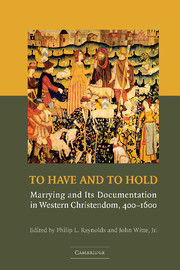Book contents
- Frontmatter
- Contents
- List of Contributors
- Preface and Acknowledgments
- List of Abbreviations
- 1 Marrying and Its Documentation in Pre-Modern Europe: Consent, Celebration, and Property
- 2 Marrying and Its Documentation in Later Roman Law
- 3 Marrying and the Tabulae Nuptiales in Roman North Africa from Tertullian to Augustine
- 4 Dotal Charters in the Frankish Tradition
- 5 Marriage and Diplomatics: Five Dower Charters from the Regions of Laon and Soissons, 1163–1181
- 6 Marriage Agreements from Twelfth-Century Southern France
- 7 Marriage Contracts in Medieval England
- 8 Marriage Contracts and the Church Courts of Fourteenth-Century England
- 9 Marrying and Marriage Litigation in Medieval Ireland
- 10 Marriage Contracts in Medieval Iceland
- 11 Contracting Marriage in Renaissance Florence
- 12 Marital Property Law as Socio-Cultural Text: The Case of Late-Medieval Douai
- 13 Marriage Contracts, Liturgies, and Properties in Reformation Geneva
- Index
7 - Marriage Contracts in Medieval England
Published online by Cambridge University Press: 12 September 2009
- Frontmatter
- Contents
- List of Contributors
- Preface and Acknowledgments
- List of Abbreviations
- 1 Marrying and Its Documentation in Pre-Modern Europe: Consent, Celebration, and Property
- 2 Marrying and Its Documentation in Later Roman Law
- 3 Marrying and the Tabulae Nuptiales in Roman North Africa from Tertullian to Augustine
- 4 Dotal Charters in the Frankish Tradition
- 5 Marriage and Diplomatics: Five Dower Charters from the Regions of Laon and Soissons, 1163–1181
- 6 Marriage Agreements from Twelfth-Century Southern France
- 7 Marriage Contracts in Medieval England
- 8 Marriage Contracts and the Church Courts of Fourteenth-Century England
- 9 Marrying and Marriage Litigation in Medieval Ireland
- 10 Marriage Contracts in Medieval Iceland
- 11 Contracting Marriage in Renaissance Florence
- 12 Marital Property Law as Socio-Cultural Text: The Case of Late-Medieval Douai
- 13 Marriage Contracts, Liturgies, and Properties in Reformation Geneva
- Index
Summary
Historians who have written about law and the institution of marriage in England can be divided into two camps. In the one stand those whose interests center in the history of the canon law on the formation of marriage, the predecessor of modern family law. In the other are historians whose principal concerns lie with the process of wealth transmission from one generation to another, the law of estates, and familial control of property. Little common ground, except the obvious factual connection created by the event of marriage, has existed between these two groups, although there has never been actual enmity or even profound disagreement. They have simply been concerned with different facets of marriage.
Besides this difference in focus, these two groups have also been separated in several ways: by the nature of the records that they examine, by the formal law to which they refer, and even by the class of the men and women that they study. For example, most historians of the canon law have devoted their primary attention to quite ordinary people: men and women whose station in society was below that of the gentry. The historians of family property, by contrast, have paid particular attention to the aristocracy and the upper gentry. Although the same formal law applied to all, practice differed in some measure depending on who the people were. The surviving evidence suggests that their concerns called for examination of different aspects of the law.
- Type
- Chapter
- Information
- To Have and to HoldMarrying and its Documentation in Western Christendom, 400–1600, pp. 260 - 286Publisher: Cambridge University PressPrint publication year: 2007
- 2
- Cited by

